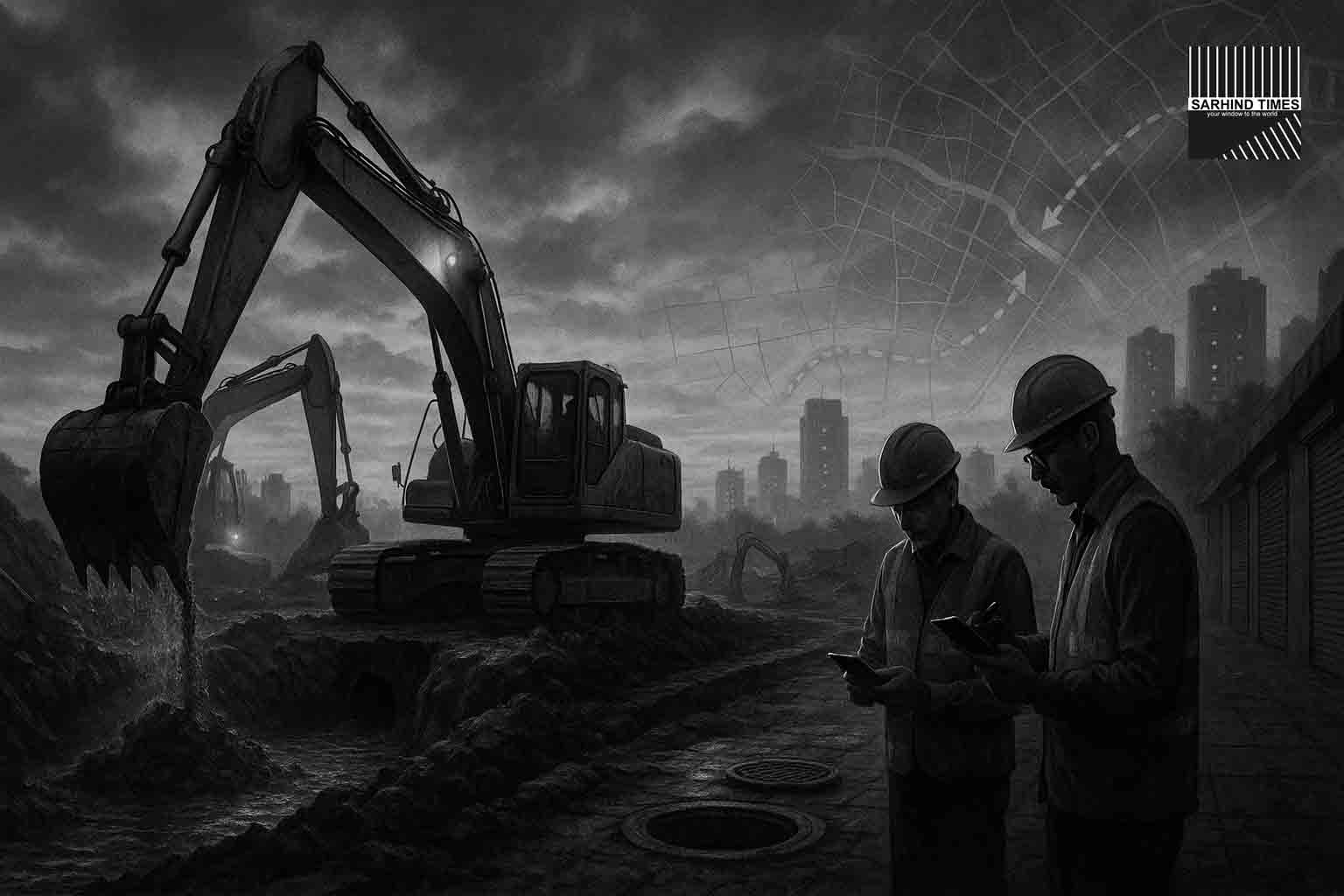By Sarhind Times City Desk | Gurugram | October 2, 2025
GURUGRAM: After another monsoon that turned arterial roads into streams and basements into sumps, the Municipal Corporation of Gurugram (MCG) has fixed an aggressive clean-up and repair window for the city’s overburdened sewage and storm-water networks: begin all pending works by December 31, 2025 and finish by April 2026. The target, set by Commissioner Pradeep Dahiya, is to deliver “durable relief” from chronic waterlogging before the next monsoon.
MCG officials say desilting has already begun at select choke points and will scale out across priority corridors that ultimately discharge into the Badshahpur drain (Leg I–III)—the city’s main outfall system feeding the Najafgarh drain. Departments have been told to coordinate with public agencies and private developers to ensure clear access for heavy machinery and to enforce no-dumping norms along storm lines. Residents’ groups welcomed the timeline but insisted on monthly dashboards to track progress and prevent slippages that have marred previous drives.
Why Now—and Why It Matters
This monsoon’s “bathtub” moments exposed the structural mismatch between the volume of water Gurugram generates in short, intense bursts and the capacity of its century-old nallahs plus patchwork storm lines to carry that load. Large catchments that once soaked rain—lakes, johads, wetlands, Aravali foothills—have shrunk or been encroached upon. What remains must be connected, cleaned, deepened and protected if the city is to keep roads open and homes dry when the skies open.
The April 2026 finish line compresses what is usually a multi-season effort into a tight, pre-monsoon sprint. In parallel, the Gurugram Metropolitan Development Authority (GMDA) is mid-way through new SPR and Dwarka Expressway drain networks—a crucial back-bone that should cut flood risk in fast-urbanising sectors. Timelines announced this summer point to SPR drains by Aug 2026 and Dwarka Expressway sector drains by May 2026, with a new Leg-IV outfall also in the pipeline to offload the overstressed Badshahpur system.
What Exactly Will Be Done Between December and April
1) City-wide Desilting & Debottlenecking
MCG’s engineering division will mechanically desilt trunk and secondary lines, cart out sludge, and jet-flush laterals that feed the trunk network, starting with corridors that repeatedly flood—stretches of Golf Course Road, Old Gurgaon, Hero Honda Chowk spurs, and sectors flanking SPR/Dwarka e-way. The plan is to raise carrying capacity before May and then hold the line with pre-monsoon “touch-ups.”
2) Repair of Collapsed Segments & Manholes
Cameras and site teams will identify sagging pipes, inverted slopes, and illegal connections. Quick-cast inlets, fresh manholes, and trenchless relining—where roads cannot be cut—are part of the toolkit. The MCG says it has already replaced hundreds of broken drain covers in quick response drives (a safety hazard during rains) and will continue to do so through winter.
3) Enforcement Against Dumping
Teams will patrol culverts and outfalls, penalising solid-waste dumping that re-clogs lines within weeks. In hotspots, gratings will be retrofitted with trash traps and a tighter collection schedule for vendor markets introduced.
4) Coordinated Works with GMDA & PWD
Because stormwater ignores ward boundaries, the drains that GMDA is laying on SPR and the Dwarka e-way must meet MCG’s lines at the right grade and invert levels. Weekly joint-reviews are planned to avoid “orphan outlets” and ensure that new drains actually connect to an outfall, not a dead-end.
5) Badshahpur Drain System—Legs I/II/III (and the proposed Leg-IV)
Desilting and section reprofiling are expected along Leg-III—a serial choke—while officials evaluate the Leg-IV outfall (Vatika Chowk to NH-48) to create fresh carrying capacity. District communication earlier documented Leg-III desilting stretches; the current drive builds on that work with deeper cuts and stricter upkeep.
6) Tech & Ops: Drones, Radar, Dashboards
The city will blend drones, ground-penetrating radar, and GIS to map silt loads, detect collapses, and plan diversions. A city control room—tested this monsoon to run pumps and suction tankers—will get ward-level dashboards so citizens can see where teams are at work.
What the Records Say: Money Spent, Problems Persist
Scrutiny is warranted. Over ₹500 crore has been spent in nine years on drain cleaning and fresh lines—yet flooding has persisted, raising uncomfortable questions about design, maintenance, and monitoring. Councillors have asked for pre-monsoon desilting (Feb–Mar) to be non-negotiable, backed by independent audits so that “cleaned” is not merely a checklist tick.
This year, the Commissioner also set near-term repair deadlines (e.g., October 15 for local civic fixes) to keep routine backlogs from snowballing into a monsoon crisis, signalling a bias for short-cycle accountability alongside the longer April 2026 push.
The Other Elephant in the Room: Bandhwari
Drainage is half the story; waste and leachate are the other half. The Bandhwari landfill remains a source of environmental anxiety—leachate reportedly escaping into the surrounding forest–agro landscape, fuelling protests and NGT scrutiny. MCG says it has administrative approval for a new project to process legacy waste; villagers want faster, verifiable progress and even relocation. The landfill’s performance will directly affect stormwater quality and downstream drains. Waterlogging + contamination is a public-health double hit the city can ill afford.
Residents Speak: “Show Us the Dashboard”
RWAs, high-rise associations, and old-city bazaar committees broadly support the timeline but want transparent yardsticks:
- Monthly progress dashboards at ward and stretch levels.
- Open data on tonnes of silt removed, km desilted, inlets repaired, illegal connections capped.
- A hotline for escalation when pumps don’t arrive or suction tankers skip scheduled rounds—plus SLAs and penalties.
- An “Encroachment Blitz” around outfalls and green channels, especially near the Aravali spurs, so rain has somewhere to go.
Commissioner Dahiya’s recent public communications have leaned precisely this way—report, respond, and show work in public view—with WhatsApp and helpline integrations flagged earlier. If the city institutionalises this culture through winter, citizens will likely give the administration latitude to finish the marathon.
Engineering Reality Check: What Causes “New Floods” in “New Sectors”
Even new neighbourhoods suffer during cloudbursts because:
- Design Assumptions: Many township drains are built for return periods that no longer reflect today’s extremes. When a “once-in-10-year” event becomes a twice-a-season reality, sections fail.
- Disconnected Systems: Project drains sometimes end at plot edges. Without a city outfall ready, developers build makeshift sumps that overflow into roads.
- Inverted Slopes & Settlements: Bad laying or road-over-drain relays invert slopes. Water backs up, flooding basements.
- Encroachments: Narrow shoulders are converted into ramps and planters, blocking inlets.
- Solid Waste: Plastic, silt, and construction debris create instant dams during the first big shower.
Addressing these requires joined-up governance—MCG, GMDA, PWD, developers—working to a single map and a single calendar. The ongoing SPR and Dwarka e-way drain projects are the big structural fix; the MCG’s December–April sprint is the operational fix that keeps today’s system breathing until the structural fix arrives.
The April 2026 Bet: Risks and Mitigations
Risk 1: Contractor Capacity & Weather Windows
Winter fog and holidays compress workdays. Mitigation: multiple packages, parallel crews, trenchless methods for “no-cut” corridors.
Risk 2: Coordination Gaps
Different agencies = different drawings. Mitigation: weekly joint reviews; publish interface plans (who meets whom where).
Risk 3: Silt Disposal Logistics
Tonnes of muck need lawful dumping to avoid “re-entry” into drains. Mitigation: earmarked sites, weigh-bridges, and GPS-logged truck movement.
Risk 4: Last-mile Sabotage
Newly cleaned inlets get clogged by illegal dumping. Mitigation: CCTV/ward marshals, on-the-spot penalties, market-day sweeps.
Risk 5: Upstream Catchments
If Bandhwari and green channels remain compromised, downstream lines will carry “dirty” loads that settle faster. Mitigation: simultaneous landfill controls and bio-remediation of key channels.
What Success Looks Like in June–September 2026
- Fewer “red” days on the city flood map; water drains in hours, not days.
- Lower pump runtime at chronic junctions—evidence that gravity is doing the work, not diesel.
- Shorter traffic snarls on rain days; emergency vehicles move.
- Cleaner outfalls at Badshahpur legs; sensor data shows sustained velocities, not stagnant pools.
- Citizen sentiment shifts from helpless outrage to routine complaint-and-closure.
These are measurable outcomes, not platitudes. The city has tried piecemeal fixes before; the difference now is the clock—December to April—and the scale of parallel works riding alongside GMDA’s structural drains.
The Fine Print: How the City Can Help Itself
- Don’t Block Inlets: Curbside planters, ramps, and car decks that cover gratings are tiny dams.
- Segregate Waste: Keep plastics and rubble out of rain paths; use collection points.
- Call In, Log Proof: Use the helpline/WhatsApp; report with geotagged photos. Follow up—data trails produce action.
- Treat Basements as Risk Zones: Install non-return valves, sump pumps with back-up power.
- RWAs as Micro-Monitors: Adopt the drain outside your gate: one fortnightly check = one monsoon saved.
The Politics of Flooding—and Why It’s Not the Story This Time
Floods make easy politics because they are visible and maddening. Yet, the documents and deadlines this season—MCG’s April 2026 pledge, GMDA’s drain projects with IIT-vetted designs, NGT-driven scrutiny of Bandhwari—suggest a rare convergence of administrative will, engineering design, and public oversight. If citizens get the promised dashboards and joint reviews actually fix interfaces, the 2026 monsoon may be the first in years to test systems, not patience.
At a Glance (Cut-out Box)
- Works start deadline: December 31, 2025
- Completion target: April 2026 (before monsoon)
- Focus: City-wide desilting, drain repairs, enforcement against dumping; alignment with GMDA’s SPR/Dwarka e-way drains; Badshahpur legs clean-up.
- Public ask: Monthly dashboards; ward-wise progress; SLA-backed response teams.
- Linked concern: Bandhwari leachate and legacy waste processing timelines.
#Gurugram #MCG #Waterlogging #UrbanInfra #Haryana #CivicIssues #Monsoon #BadshahpurDrain #GMDA #Bandhwari






















+ There are no comments
Add yours